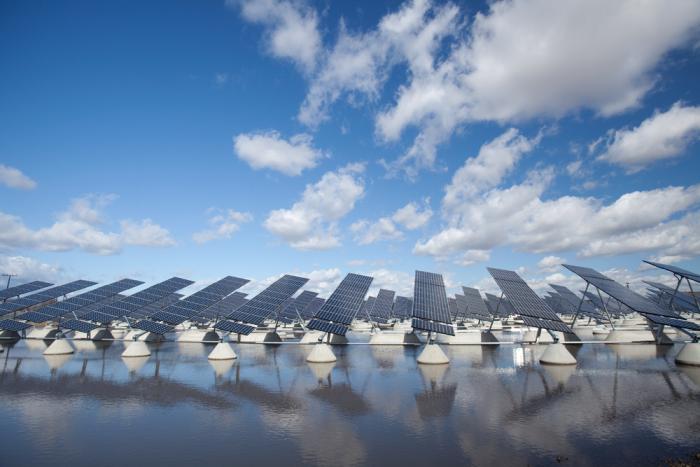
Editor’s Note: In 2020, SunPower announced the completion of the strategic spin-off of its manufacturing division into a separate business named Maxeon Solar Technologies, Ltd. As a result, SunPower has expanded its offerings to drive future growth. The SunPower Equinox® system now offers multiple panel options, including front- and back-contact panels, all of which are responsibly and rigorously quality tested to provide the best energy solution for your home. For more information on the differences in panel technology, view our Better Solar Panels page.
The modern world runs on a partnership between water and energy production. Conventional energy sources use a tremendous amount of water to produce electricity, and — in addition — it takes a lot of energy to make drinkable water.
A water shortage can mean a crisis for the energy industry. But the good news is that photovoltaic (PV) solar power helps significantly reduce the amount of water needed to make energy and helps save water districts money.
Conventional power generation is a thirsty business. Power plants that rely on coal, oil, gas or nuclear power use more than 40 percent of fresh water withdrawn for human uses (drinking, irrigation etc.) in the United States. This makes them the country’s biggest water consumers. But this enormous water consumption doesn’t stop there. Plants using fossil fuels need water to control air pollution, and conventional power producers gulp water indirectly for things such as fuel extraction, production, refining and transportation. Coal and nuclear plants can use anywhere from 25 to 60 gallons of water to produce just one kilowatt hour of electricity.
To generate energy, these power plants return much of their water back to nature (though this return is always accompanied by thermal pollution). But what happens when there isn’t enough water for them to use?
In 2011, Texas saw its worst drought since the 1950s. As a result, one East Texas coal-fired plant had to bring in water from a distant river. Others were on the verge of scaling back operations or shutting down. If the drought had continued, much of the state might have seen power plant closures and electricity rate spikes.
Texas is not alone. Drought-related problems have cropped up at power plants from Nevada to New England since 2006.
Solar Energy Doesn’t Rely on Water
Solar energy offers a much more earth friendly way to produce electricity.
At SunPower, we aim to be a regenerative force by designing and manufacturing solar products that are as sustainable as the clean energy they produce. We accomplish this through our “beneficial by design” product development approach and Light on Land™ development practices that address potential environmental issues such as habitat loss, water over-use, or the use of potentially hazardous materials. Overall, it takes just a few cups of water — not dozens of gallons — to make one kilowatt hour of solar energy.
Some water is required to clean solar panels so they operate at maximum efficiency. Seasonal rainfall and snowmelt are usually enough to keep residential solar panels dust free. Commercial or utility users with large arrays use SunPower’s robot solar panel cleaners, which use very little precious H2O.
SunPower’s robots use 75 percent less water than manual cleaning, requiring less than half a cup of water per panel.1 They also work at night so that they don’t interfere with energy production. Savings like this help explain why SunPower has attracted top business, agricultural and government clients in recent years. And it’s why large scale solar power plants are being built around the world.
Solar Power for Water Districts & Ag Industry
On the other side of the water story is what’s used by your household. Your municipal water treatment facility has to pump, treat and retreat wastewater while also purifying and process your drinking water.
The cost of that process has been skyrocketing in many parts of the country. In the high desert of San Benardino County, Calif., the Phelan Piñon Hills Community Services District, which operates the area’s public water system, saw its energy bill increase by more than $300,000 within a couple of years, and higher prices loomed. District leaders realized they had to do something to bring down those costs.
The district partnered with SunPower to repurpose a retired dairy farm into a 1.5 megawatt solar power system. This solar system now produces enough energy to offset 40 percent of the district’s water-producing electricity costs through an innovative bill credit program that allows energy generated at one site to offset the electricity costs of other meters in the same district. The Phelan Piñon Hills Community Services District expects to save $13 million over 30 years.
To learn how this project has helped the community, watch our video: Solar Helps Water District Serve Desert Community in California.
The agriculture industry, an especially water-intensive business, has increasingly embraced solar as a way to combat rising electricity costs. From almond processors to mushroom growers and wineries, more food and beverage companies are going solar to reduce their bottom line while doing something that’s good for the environment.
Elsewhere, water-related energy costs continue to rise. While our planet has 8 million cubic miles of freshwater — far more than humans need at any given time — that water is not always where it’s most needed.
Fast-growing cities such as Las Vegas are having to pump in water from greater distances to keep up with demand. The Las Vegas Water District was a Nevada solar pioneer back in 2007 when it installed SunPower solar technology to offset its water pumping electricity costs.
Some cities have built plants that turn saltwater into freshwater. Such schemes are energy-intensive and are guaranteed to drive costs higher. They also highlight the vicious cycle nagging policymakers in both the public and private sectors: Without enough water, you can’t have power; without enough power, you can’t have water. SunPower has worked with many public agencies to offer solar solutions for this dilemma.
There are many other ways out of this conundrum. Some involve better policies that promote water conservation, while others involve technological changes, such as more efficient power plants. But solar provides a cost-effective solution worth considering.
1Based on experience with robotic cleaning at actual SunPower sites, compared to data tracked by subcontracted manual cleaners utilized at a SunPower project.
© 2017 SunPower Corporation. All Rights Reserved. SUNPOWER, the SUNPOWER logo, and LIGHT ON LAND are trademarks or registered trademarks of SunPower Corporation in the U.S. and other countries as well.

